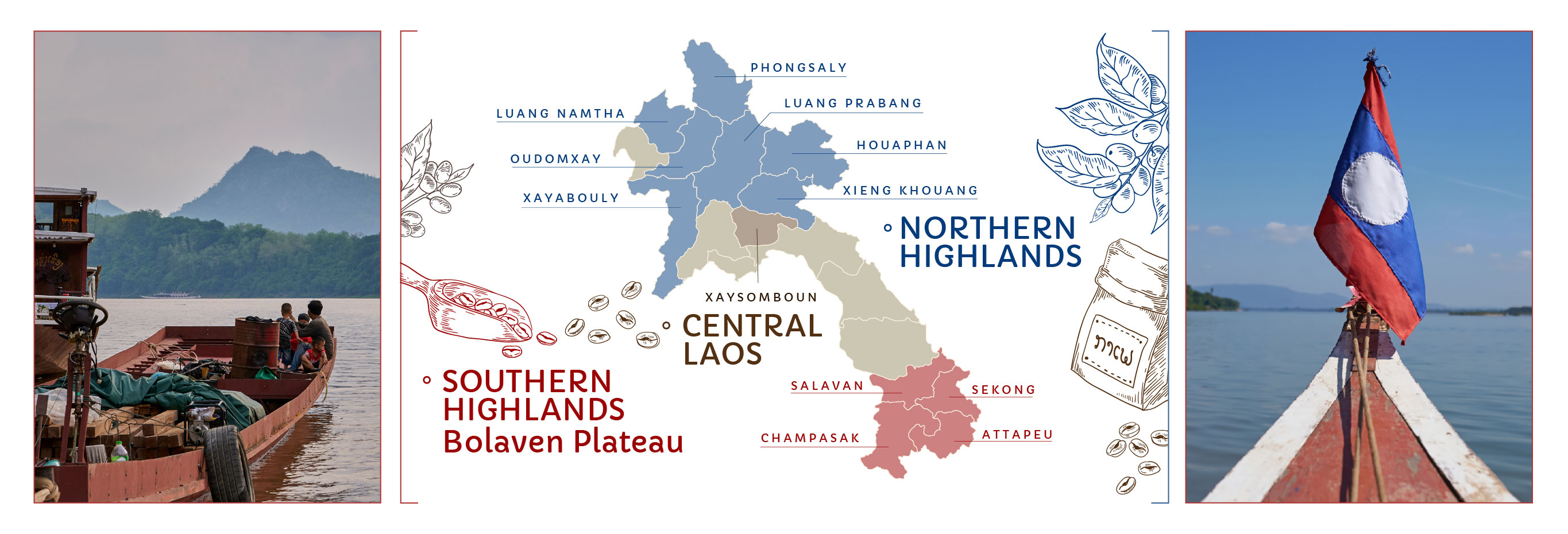Coffee in Xiang Khouang Province
Xiang Khouang province in central Laos spans 15,880 km2 of rugged mountains, hills and valleys. 90% of the land is steep slopes and dense forests, while the Xiangkhouang Plateau, at over 1,000 m high, has excellent conditions for coffee cultivation.
Temperatures range from 20°C in cooler months to 28°C in May, with peak rainfall in August, fostering coffee with flavors of dry fruit and florals with a hint of green tea.
Phonsavanh, the provincial capital, is developing a small but growing coffee culture. Local spots like Cranky-T Cafe and Mueang Xieng Cafe, introduce visitors to regional brews. The province is accessible via roads linking neighbouring provinces and Vietnam, and the airport has daily flights to Vientiane.
Numerous rivers, including the Nam Mat, wind through the valleys, supporting agriculture and habitats for traditional plants used by farmers.
Protected areas like Phou Sabot-Poung Chong NPA and Nam Et-Phou Leoi NPA cover 58% of the province, critical for biodiversity.
Coffee farming is expanding on mountain slopes, providing a sustainable income for communities and complementing traditional farming methods in terraced rice fields.
Xiang Khouang is home to approximately 250,000 people, including ethnic groups such as Lao Loum, Thai Phuan, Hmong, Khmu, and Tai Dam. This cultural diversity enriches local farming and coffee cultivation efforts.
Plain of Jars is an intriguing and mysterious archaeological site at Thomghaihin in Xiang Khouang province
Case Study – The Lone Buffalo Student Coffee Cooperative
Initiated by youth in Xiang Khouang, the Lone Buffalo is a live working environment for students to develop practical business skills. They also produce “Bombs to Beans Coffee” a premium Arabica grown at altitude by smallholder farmers.
The cooperative adopts a hands-on learning approach where students assist farmers during the harvest season. They gain practical experience in various coffee processing methods, including washing, hulling, and drying techniques, while also building business skills.
The cooperative operates a structured distribution system, preparing new orders monthly. Freshly roasted coffee is delivered to cafes in Phonsavan, Luang Prabang and Vientiane.
This initiative represents a powerful transformation, turning a war-torn region into a thriving coffee-producing area while providing valuable educational and economic opportunities for local youth.
Mark Steadman, co-founder of the Lone Buffalo English and Youth Development Centre, aims to empower local youth in Xieng Khouang province. Photo by Nicole Motteux,
Viengxay Caves
Origin Highights
Plain of Jars
In coffee-growing villages, it is common to see UXO warning posters, reminding communities of the dangers that still linger from past conflicts. Photo by Nicole Motteux
Coffee farming boosts incomes and connects rural highlands in Xieng Khouang Province, supporting sustainable livelihoods and preserving cultural heritage among ethnic communities.
Xiang Khouang is also known for the UNESCO-listed Plain of Jars. This remarkable historical site features thousands of stone jars scattered across upland valleys and lower foothills of the central plain, dating back to 1240–660 BC.
The jars are arranged in clusters ranging from one to several hundred. More than 90 jar sites have been identified in Xiang Khouang province with each site containing 1–400 jars.
Carved from sandstone, granite, conglomerate, limestone, and breccia, each jar is 1–3 m in height and diameter. They are cylindrical with a wide base and are generally undecorated, except for a single jar at Site 1, near the town of Phonsavan. This site holds special significance and is the most explored and visited.
Between 1964 and 1969, the Plain of Jars was heavily bombed by the United States Air Force during operations against North Vietnamese and Pathet Lao communist forces in the Secret War. The area remains one of the most UXO-contaminated areas in Laos, with unexploded bombs, particularly cluster munitions, restricting free movement.
Evidence of the bombing can be seen in broken or displaced jars and bomb craters. Sightseeing is only safe along cleared and marked pathways, with seven jar sites now cleared of unexploded bombs and open to visitors.
This deadly legacy continues to devastate agriculture, worsen food insecurity, and hinder sustainable livelihoods.
UXO clearance is ongoing and so far, has restored over 11,700 hectares of farmland. As demining advances, coffee cultivation is making a comeback, inspiring the name "From Bombs to Beans."
Case Study – COMMA Coffee
For more than a decade, popular Vientiane coffee chain, COMMA Coffee, has worked with the Keoset Community Coffee in Ban Tantai village in Xiang Khouang to improve coffee quality and local incomes.
COMMA Coffee started by introducing small-scale processing centres in local villages, helping farmers to shift from selling raw coffee cherries to more profitable green beans.
They also serve as training hubs, equipped with modern tools for processing and quality control.
A key element of the project is empowering local women by training them in coffee cultivation and processing, turning them into trainers. This approach improves coffee quality and fosters community development.
The Keoset Community project includes several villages and has significantly improved the livelihoods of 200 farming families.
Explore Laos' coffee stories at Naked Espresso cafe. Photo by Nicole Motteux
Coffee production in Xieng Khouang, Laos, empowers local communities to produce award-winning coffee. Photo by Nicole Motteux
Within just two years, this initiative has transformed the local coffee scene. Farmers have progressed from basic cherries to specialty-grade green beans, increasing their income and placing Ban Tantai on the global coffee map.
In 2022, Keoset won the annual Taste of Laos competition in Vientiane, where their Arabica beans scored 84.29 from the Coffee Quality Institute (CQI).
COMMA Coffee aims to increase green bean production to five tons by 2028, focusing on expanding into domestic markets.












